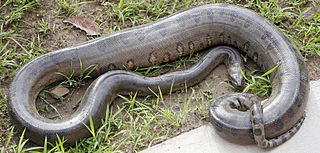
Anacondas or water boas are a group of large snakes of the genus Eunectes. They are found in tropical South America. Four species are currently recognized.

Colubridae is a family of snakes. With 249 genera, it is the largest snake family. The earliest species of the family date back to the Oligocene epoch. Colubrid snakes are found on every continent except Antarctica.

Taipans are snakes of the genus Oxyuranus in the elapid family. They are large, fast-moving, highly venomous, and endemic to Australia and New Guinea. Three species are recognised, one of which, the coastal taipan, has two subspecies. Taipans are some of the deadliest known snakes.

The Leptotyphlopidae are a family of snakes found in North America, South America, Africa and Asia. All are fossorial and adapted to burrowing, feeding on ants and termites. Two subfamilies are recognized.

Drymarchon is a genus of large nonvenomous colubrid snakes, commonly known as indigo snakes or cribos, found in the Southeastern United States, Central America, and South America.

The tiger snake is a large and highly venomous snake of southern Australia, including its coastal islands and Tasmania. These snakes are often observed and locally well known by their banding, black and yellow like a tiger, although the species can be highly variable in coloration and patterning. All populations are classified within the genus Notechis (Elapidae). Their diverse characteristics have been classified either as distinct species or by subspecies and regional variation.

Ophichthidae is a family of fish in the order Anguilliformes, commonly known as the snake eels. The term "Ophichthidae" comes from Greek ophis ("serpent") and ichthys ("fish"). Snake eels are also burrowing eels. They are named for their physical appearance, as they have long, cylindrical, snake-like bodies. This family is found worldwide in tropical to warm temperate waters. They inhabit a wide range of habitats, from coastal shallows and even rivers, to depths below 800 m (2,600 ft). Most species are bottom dwellers, hiding in mud or sand to capture their prey of crustaceans and small fish, but some are pelagic.

The marsh mongoose, also known as the water mongoose or the vansire, is a medium-sized mongoose native to sub-Saharan Africa that inhabits foremost freshwater wetlands. It has been listed as Least Concern on the IUCN Red List since 2008.

The Argentine snake-necked turtle, also known commonly as the South American snake-necked turtle is a species of turtle in the family Chelidae. The species is known for the long neck to which its common names refer. Despite appearances, the Argentine snake-necked turtle is probably more closely related to the mata mata than to the Australian snake-necked turtles in the genus Chelodina. H. tectifera is found in northern Argentina, Uruguay, Paraguay, and southern Brazil. Not much is known about it, as it has not been extensively researched. It is a popular pet in the exotic pet trade.

Aegialomys is a genus of oryzomyine rodents from the lowlands and mountains of western Peru and Ecuador, including the Galápagos Islands. The species in this genus have historically been placed in Oryzomys, but according to cladistic research, the genus is more closely related to a group containing, among others, Nectomys and Sigmodontomys, than to Oryzomys. The generic name Aegialomys means "coastal mouse" in Ancient Greek and references the mostly coastal occurrence of the genus.
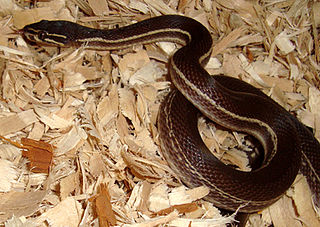
Boaedon is a genus of African lamprophiids consisting of the "brown" house snakes. The genus was originally described by Duméril but the species contained were reclassified as Lamprophis by Fitzinger in 1843, this taxonomy remained widely accepted until November 2010 when a phylogenetic study was published by C.M.R Kelly et al. who resurrected the Boaedon clade. Although commonly regarded as belonging to the Colubridae, primary literature usually lists them and related species as belonging to the family Lamprophiidae within the superfamily Elapoidea which includes among other non-venomous families the venomous cobras and mambas in the family Elapidae.

Atractus is a genus of colubrid ground snakes in the subfamily Dipsadinae. The genus includes more than 140 distinct species.

The coastal taipan, or common taipan, is a species of extremely venomous snake in the family Elapidae. Described by Wilhelm Peters in 1867, the species is native to the coastal regions of northern and eastern Australia and the island of New Guinea. The second-longest venomous snake in Australia, the coastal taipan averages around 2.0 m (6.6 ft) long, with the longest specimens reaching 2.9 m (9.5 ft) in length. It has light olive or reddish-brown upperparts, with paler underparts. The snake is considered to be a least-concern species according to the International Union for Conservation of Nature.

Dipsadinae is a large subfamily of colubroid snakes, sometimes referred to as a family (Dipsadidae). They are found in most of the Americas, including the West Indies, and are most diverse in South America. There are more than 700 species.

Apostolepis is a genus of snakes in the subfamily Dipsadinae. However, the familial placement differs among sources. It has also been placed in the family Colubridae, subfamily Dipsadinae or Xenodontinae, or in the family Xenodontidae. The genus Apostolepis is endemic to South America.
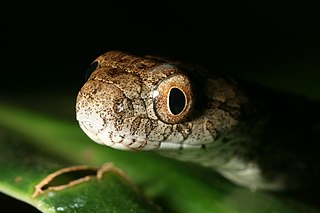
Thamnodynastes is a genus of snakes of the family Colubridae.

Siphlophis is a genus of snakes of the family Colubridae. The genus is endemic to the Americas.

Dryophylax is a genus of snakes of the family Colubridae.
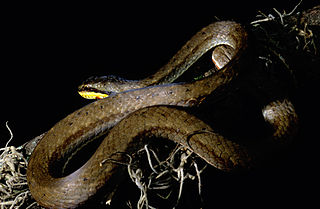
Mesotes rutilus, Prado's coastal house snake, is a species of snake in the family Colubridae. The species is native to Brazil.
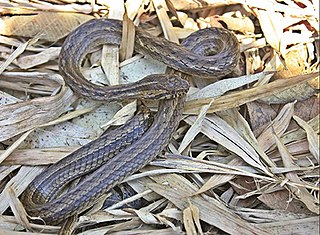
Mesotes strigatus, the coastal house snake, is a species of snake in the family Colubridae. The species is native to Argentina, Uruguay, Paraguay, and Brazil.



















